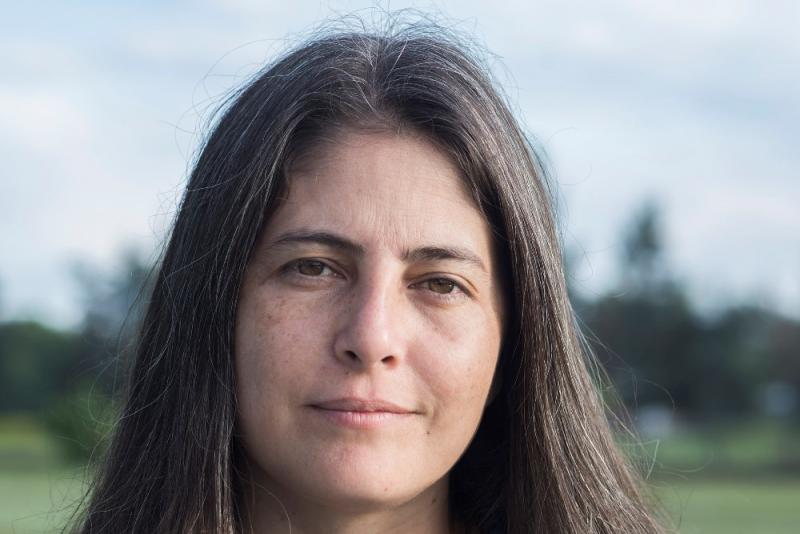Selva Almada: Dead Girls review – the stark proximity of women to violence | reviews, news & interviews
Selva Almada: Dead Girls review – the stark proximity of women to violence
Selva Almada: Dead Girls review – the stark proximity of women to violence
Almada's hybrid writing bears searing witness to the horrors of femicide

Selva Almada’s newly translated work has a stark title in both English and the original Spanish: Dead Girls, or Chicas Muertas. That apparent bluntness belies the hybrid sensitivity that makes up the pages. Its subject matter is the murders of three young women during the 1980s, spread across different provinces of Argentina, a country where murders of and violence against women are unbearably commonplace.
It is also about growing up in a system where violence against women goes unpunished. As Almada shows in the book, there is nothing particularly unusual about these cases, nor about the women themselves. In fact, much of the book is about the danger of simply being a woman in Argentina: a place where each day you are aware of your own proximity to violence. Almada explains in her Author’s Note: “As I wrote the stories of Andrea, Maria Luìsa and Sarita, fragments of my own life story and those of women I knew began to work their way in. My friends and I were still alive, but we could have been Andrea, Maria Luìsa or Sarita. We were just luckier.”

The book does not take the form of a straight investigation or mystery story, though its tone is often journalistic: instead Almada looks for different points of contact between her life and the three young women, speaking with their families, going through case notes, imagining re-enactments of their last movements and moments, and even consulting a tarot card reader. The text moves in between these different communications: the “I” in some places morphs from Almada’s voice into the testimony of a brother or friend, and then again from an account of her own life into stories about other people’s and descriptive narrations of her research trips. This formal flexibility produces an unassuming yet intensely felt narrative in which the writer pays moving tribute to these young women while examining the conditions within the society that allowed for their deaths.
The first chapter opens in 1986 with a young Almada hearing on the radio that a nineteen-year-old girl has been killed in a nearby town, stabbed as she was sleeping in her bed. For Almada, this news exposes the flimsy protection her home life affords: “I was thirteen, and that morning the news about the dead girl hit me like a revelation. My house, any teenager’s house, wasn’t really the safest place in the world … Horror could live with you, under your roof.” Later, she thinks about stories told to her by her mother, in which the possibility of violence is never named explicitly but always implied: “I don’t remember a specific conversation about violence against women, or any particular warnings from my mother on the subject. But the topic was always there.”
This presence of violence is compounded by the fact that the three murders she discusses in this text are unsolved. Almada does not try to use her writing as a means of solving them, but instead thinks about their lack of conclusion, and the possibility that they have to be rewritten, rehashed, even mythologised as part of local lore. Everyone knows about certain killings, and the murder of fifteen-year-old Maria Luìsa periodically appears in the papers as a sensationalised mystery, in which prurient journalists speculate about her sex life, her relationships and her behaviour. In her simple, descriptive language, rendered meticulously in the translation by Annie McDermott, Almada goes in the opposite direction, giving these horrific events a grounding in the life of all Argentinians.
But Almada is also attentive to a crucial aspect of these murders, detailing the class differences between the women she describes, and taking care to outline the distinct details of their life, family and work. Andrea is a student, Maria Luìsa works as a maid and Sarita worked in various jobs before turning to sex work. Many of Almada’s friends in school also had jobs and though Almada saw her friends who had a little of their own money as “superior…Confident, streetwise”, the need to work is looked down upon by others she knows. Though the writer doesn’t always make it obvious, these judgements give a telling insight into the societal belief that there are some women whose deaths are more tolerable than others.
As her book comes to its end, Almada lights three white candles in remembrance of these young women. Her writing cannot give an answer for their deaths, but it can provide a kind of witnessing, a way of attesting that these lost lives have value, long after their stories have lost their novelty.
- Dead Girls by Selva Almada translated by Annie McDermott (£9.99, Charco Press)
- Read more book reviews on theartsdesk
The future of Arts Journalism
You can stop theartsdesk.com closing!
We urgently need financing to survive. Our fundraising drive has thus far raised £49,000 but we need to reach £100,000 or we will be forced to close. Please contribute here: https://gofund.me/c3f6033d
And if you can forward this information to anyone who might assist, we’d be grateful.

Subscribe to theartsdesk.com
Thank you for continuing to read our work on theartsdesk.com. For unlimited access to every article in its entirety, including our archive of more than 15,000 pieces, we're asking for £5 per month or £40 per year. We feel it's a very good deal, and hope you do too.
To take a subscription now simply click here.
And if you're looking for that extra gift for a friend or family member, why not treat them to a theartsdesk.com gift subscription?
more Books
 'We are bowled over!' Thank you for your messages of love and support
Much-appreciated words of commendation from readers and the cultural community
'We are bowled over!' Thank you for your messages of love and support
Much-appreciated words of commendation from readers and the cultural community
 Thomas Pynchon - Shadow Ticket review - Pulp Diction
Thomas Pynchon's latest (and possibly last) book is fun - for a while
Thomas Pynchon - Shadow Ticket review - Pulp Diction
Thomas Pynchon's latest (and possibly last) book is fun - for a while
 Justin Lewis: Into the Groove review - fun and fact-filled trip through Eighties pop
Month by month journey through a decade gives insights into ordinary people’s lives
Justin Lewis: Into the Groove review - fun and fact-filled trip through Eighties pop
Month by month journey through a decade gives insights into ordinary people’s lives
 Joanna Pocock: Greyhound review - on the road again
A writer retraces her steps to furrow a deeper path through modern America
Joanna Pocock: Greyhound review - on the road again
A writer retraces her steps to furrow a deeper path through modern America
 Mark Hussey: Mrs Dalloway - Biography of a Novel review - echoes across crises
On the centenary of the work's publication an insightful book shows its prescience
Mark Hussey: Mrs Dalloway - Biography of a Novel review - echoes across crises
On the centenary of the work's publication an insightful book shows its prescience
 Frances Wilson: Electric Spark - The Enigma of Muriel Spark review - the matter of fact
Frances Wilson employs her full artistic power to keep pace with Spark’s fantastic and fugitive life
Frances Wilson: Electric Spark - The Enigma of Muriel Spark review - the matter of fact
Frances Wilson employs her full artistic power to keep pace with Spark’s fantastic and fugitive life
 Elizabeth Alker: Everything We Do is Music review - Prokofiev goes pop
A compelling journey into a surprising musical kinship
Elizabeth Alker: Everything We Do is Music review - Prokofiev goes pop
A compelling journey into a surprising musical kinship
 Natalia Ginzburg: The City and the House review - a dying art
Dick Davis renders this analogue love-letter in polyphonic English
Natalia Ginzburg: The City and the House review - a dying art
Dick Davis renders this analogue love-letter in polyphonic English
 Tom Raworth: Cancer review - truthfulness
A 'lost' book reconfirms Raworth’s legacy as one of the great lyric poets
Tom Raworth: Cancer review - truthfulness
A 'lost' book reconfirms Raworth’s legacy as one of the great lyric poets
 Ian Leslie: John and Paul - A Love Story in Songs review - help!
Ian Leslie loses himself in amateur psychology, and fatally misreads The Beatles
Ian Leslie: John and Paul - A Love Story in Songs review - help!
Ian Leslie loses himself in amateur psychology, and fatally misreads The Beatles
 Samuel Arbesman: The Magic of Code review - the spark ages
A wide-eyed take on our digital world can’t quite dispel the dangers
Samuel Arbesman: The Magic of Code review - the spark ages
A wide-eyed take on our digital world can’t quite dispel the dangers
 Zsuzsanna Gahse: Mountainish review - seeking refuge
Notes on danger and dialogue in the shadow of the Swiss Alps
Zsuzsanna Gahse: Mountainish review - seeking refuge
Notes on danger and dialogue in the shadow of the Swiss Alps

Add comment